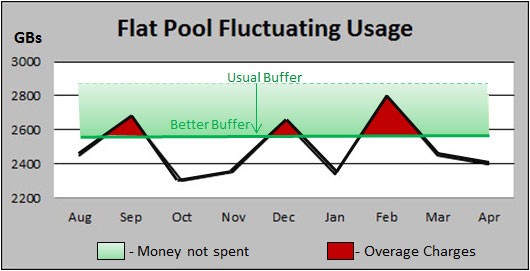blog | Kit Livingston
| September 27, 2017 12:12 pm
| Leave a Comment
| invoice optimization, mobile cost management, MobilSentry, wireless expense managment
Optimizing Invoices in Today’s Data-Centric Wireless World
 The concept of shifting away from voice-metered plans to data-metering first emerged in 2013. In the years since, most businesses have migrated to data pooling primarily because the carriers offer unlimited voice and messaging incentives for data-centric plans. Two general pooling plan types are offered today in the industry. Carriers like AT&T and Verizon offer you a choice of both pooling models while other carriers tend to focus on one variation or the other. To understand the economics of these two pooling models and make the best decisions for your company situation, it is important to appreciate the pros and cons of each model and know how to effectively project your data quantity needs in the pooling model you select.
The concept of shifting away from voice-metered plans to data-metering first emerged in 2013. In the years since, most businesses have migrated to data pooling primarily because the carriers offer unlimited voice and messaging incentives for data-centric plans. Two general pooling plan types are offered today in the industry. Carriers like AT&T and Verizon offer you a choice of both pooling models while other carriers tend to focus on one variation or the other. To understand the economics of these two pooling models and make the best decisions for your company situation, it is important to appreciate the pros and cons of each model and know how to effectively project your data quantity needs in the pooling model you select.
Understanding Pooling Types
The pooling models fall into what we call ‘Group Share’ and ‘Data Plus’ packages. Both offer unlimited voice and messaging with their unit of measure based on the number of gigabytes consumed. In the Group Share category, data is purchased in bulk quantities (10s to 100s of GB) with limits placed on the permitted number of devices within a group/pool. The Data Plus type plans either allow an unlimited number of devices or usage boundaries are sufficiently elevated to remove most practical limitations. Similar to how classic voice pools use to operate, Data Plus makes a small contribution (1 – 10 GB) toward the aggregate pool total from each device. To get to the total amount needed in a pool, you need to ensure the sum of all parts will achieve your predetermined goal.
MobilSentry™, a mobile expense management solution, can provide a platform for rate plan optimization and includes disciplines for determining which strategy is best for you. Click here to download our white paper, Optimizing Invoices in Today’s Data-Centric Wireless World.